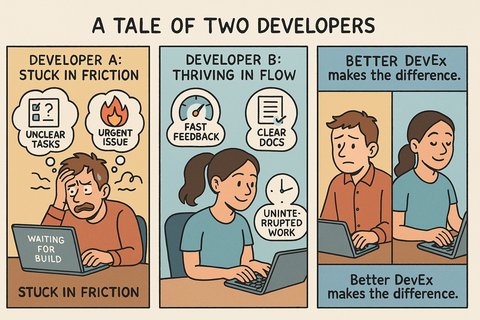From Friction to Focus: Improving Developer Experience
April 14, 2025 by Sharjeel Aziz3 minutes
Imagine a developer pushes a commit and opens a pull request—but the build takes forever to complete. While waiting, they open a ticket for another task. Unfortunately, this ticket lacks clear context and has insufficient details. As they're writing notes to seek clarification, they're interrupted by a request for help with an urgent site reliability issue. They join an online meeting and can't work on anything else until it's resolved. Meanwhile, the initial build fails, forcing the developer to fix the issues, commit again, and endure the wait all over again. After more waiting and repeated cycles, the pull request finally gets approved.
If every day unfolds like this, developers struggle to do their best work. They are stuck in friction.
 This illustration was created using Sora, OpenAI’s AI video generation tool.
This illustration was created using Sora, OpenAI’s AI video generation tool.
Understanding Developer Experience (DevEx)
Organizations commonly measure developer productivity through metrics like velocity, story points completed, or lead times. However, these metrics often miss the full picture. A high productivity score might simply reflect overwork or individual heroics.
Developer Experience (DevEx) offers a deeper understanding. It reflects how developers feel about their work, the friction they encounter daily, and how it impacts their ability to deliver quality software. A positive DevEx boosts productivity, efficiency, quality, and employee retention.
Frequent interruptions, unclear goals, and inefficient tools negatively affect DevEx, while clear tasks, well-organized code, and smooth release processes greatly improve it.
Three Key Areas of Developer Experience
DevEx revolves around three core dimensions:
- Feedback Loops: Developers depend on quick feedback from tools and colleagues. Slow feedback loops—such as delayed builds or reviews—lead to frustration and delays. Improving these loops involves optimizing tools, automating tasks, and streamlining communication.
- Cognitive Load: Software development is inherently complex. High cognitive load—stemming from poorly documented code or complicated systems—slows developers down and leads to mistakes. Clear documentation, simple tools, and easy onboarding processes can significantly reduce cognitive load.
- Flow State: Developers thrive when fully engaged in their work without disruptions. Unnecessary meetings, unclear objectives, and constant interruptions disrupt their flow. You can foster flow state by reducing distractions, promoting autonomy, and establishing clear, achievable goals.
Practical Strategies for Improving DevEx
Microsoft’s Code With Engineering Playbook provides actionable recommendations aligned with the three DevEx dimensions:
Streamlining Feedback Loops
- Fast End-to-End Setup: Minimize the time it takes from repository cloning to running the application.
- Standardization: Ensure consistency in building, testing, and debugging processes.
- Observability: Use robust logging and metrics for immediate feedback on system behavior.
Reducing Cognitive Load
- Effective Onboarding: Provide comprehensive guides detailing project setup, processes, and team workflows.
- Cross-Platform Consistency: Utilize tools like DevContainers or Docker compose based sandboxes to standardize development across different operating systems.
- Local Development: Minimize dependencies on external systems by using local emulators, containers to emulate services like RDS or Redis, or mocks.
Encouraging Flow State
- DevEx Champions: Designate individuals responsible for identifying workflow improvements and advocating for better processes.
- Atomic Pull Requests: Encourage smaller, focused pull requests to ease reviews and reduce context switching.
- Fewer Repositories: Consolidate repositories to simplify navigation and collaboration.
Measuring DevEx: Key Metrics
Measuring DevEx effectively requires tracking both how developers feel (Perceptions) and how efficiently processes run (Workflows):
| Dimension | Developer Perceptions | Workflow Metrics |
|---|---|---|
| Feedback Loops | Satisfaction with build speed and deployments | CI/CD times, code review turnaround |
| Cognitive Load | Ease of understanding systems and documentation | Time spent seeking technical answers |
| Flow State | Ability to focus, clarity of tasks | Frequency of interruptions and meetings |
Combining Metrics for a Complete Picture
To fully understand and enhance DevEx, combine:
- Perception Surveys: Gather regular feedback on developers’ experiences.
- Workflow Analytics: Monitor measurable processes like code reviews and deployments.
- North Star Metrics: Align DevEx improvements with broader business goals, such as reduced lead times and fewer production incidents.
By systematically addressing these areas, you can create environments where developers are empowered to produce their best work.